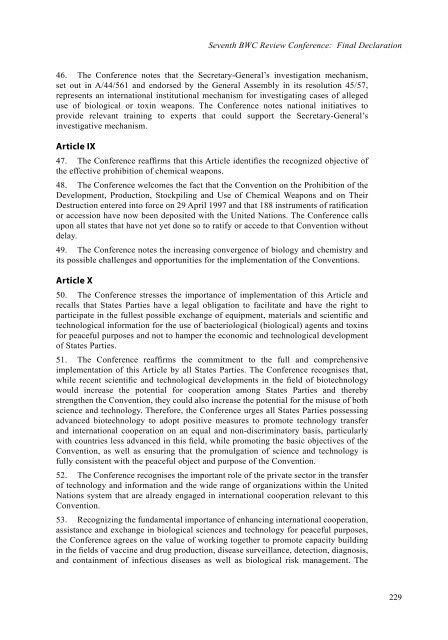DYB2011-Part-II-web
DYB2011-Part-II-web
DYB2011-Part-II-web
You also want an ePaper? Increase the reach of your titles
YUMPU automatically turns print PDFs into web optimized ePapers that Google loves.
Seventh BWC Review Conference: Final Declaration<br />
46. The Conference notes that the Secretary-General’s investigation mechanism,<br />
set out in A/44/561 and endorsed by the General Assembly in its resolution 45/57,<br />
represents an international institutional mechanism for investigating cases of alleged<br />
use of biological or toxin weapons. The Conference notes national initiatives to<br />
provide relevant training to experts that could support the Secretary-General’s<br />
investigative mechanism.<br />
Article IX<br />
47. The Conference reaffirms that this Article identifies the recognized objective of<br />
the effective prohibition of chemical weapons.<br />
48. The Conference welcomes the fact that the Convention on the Prohibition of the<br />
Development, Production, Stockpiling and Use of Chemical Weapons and on Their<br />
Destruction entered into force on 29 April 1997 and that 188 instruments of ratification<br />
or accession have now been deposited with the United Nations. The Conference calls<br />
upon all states that have not yet done so to ratify or accede to that Convention without<br />
delay.<br />
49. The Conference notes the increasing convergence of biology and chemistry and<br />
its possible challenges and opportunities for the implementation of the Conventions.<br />
Article X<br />
50. The Conference stresses the importance of implementation of this Article and<br />
recalls that States <strong>Part</strong>ies have a legal obligation to facilitate and have the right to<br />
participate in the fullest possible exchange of equipment, materials and scientific and<br />
technological information for the use of bacteriological (biological) agents and toxins<br />
for peaceful purposes and not to hamper the economic and technological development<br />
of States <strong>Part</strong>ies.<br />
51. The Conference reaffirms the commitment to the full and comprehensive<br />
implementation of this Article by all States <strong>Part</strong>ies. The Conference recognises that,<br />
while recent scientific and technological developments in the field of biotechnology<br />
would increase the potential for cooperation among States <strong>Part</strong>ies and thereby<br />
strengthen the Convention, they could also increase the potential for the misuse of both<br />
science and technology. Therefore, the Conference urges all States <strong>Part</strong>ies possessing<br />
advanced biotechnology to adopt positive measures to promote technology transfer<br />
and international cooperation on an equal and non-discriminatory basis, particularly<br />
with countries less advanced in this field, while promoting the basic objectives of the<br />
Convention, as well as ensuring that the promulgation of science and technology is<br />
fully consistent with the peaceful object and purpose of the Convention.<br />
52. The Conference recognises the important role of the private sector in the transfer<br />
of technology and information and the wide range of organizations within the United<br />
Nations system that are already engaged in international cooperation relevant to this<br />
Convention.<br />
53. Recognizing the fundamental importance of enhancing international cooperation,<br />
assistance and exchange in biological sciences and technology for peaceful purposes,<br />
the Conference agrees on the value of working together to promote capacity building<br />
in the fields of vaccine and drug production, disease surveillance, detection, diagnosis,<br />
and containment of infectious diseases as well as biological risk management. The<br />
229


